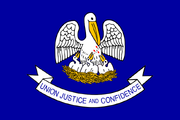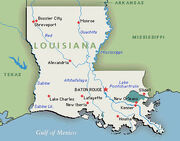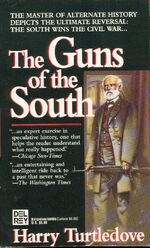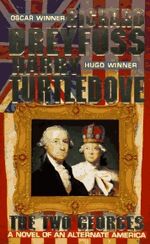

Louisiana is a state located in the southern region of the United States. It is the 31st most extensive and the 25th most populous of the 50 United States. Its capital is Baton Rouge and largest city is New Orleans. Louisiana is bordered by Arkansas to the north, Mississippi to the east, Texas to the west, and the Gulf of Mexico to the south.
Some Louisiana urban environments have a multicultural, multilingual heritage, being so strongly influenced by an admixture of 18th century French, Spanish and African cultures that they have been considered somewhat exceptional in the U.S. Before the American influx and statehood at the beginning of the 19th century, the territory of current Louisiana State had been a Spanish and French colony. In addition, the pattern of development included importing numerous African slaves in the 18th century, with many from the same region of West Africa, thus concentrating their culture. Louisiana became the eighteenth state on April 30, 1812.
Louisiana in The Guns of the South[]
Louisiana seceded from the Union during the Second American Revolution and joined the Confederacy. New Orleans was captured in 1862, as were other parts of the state. These Union holdings became a moot point when Robert E. Lee's Army of Northern Virginia captured Washington City in 1864, forcing the U.S to agree to a ceasefire. One of the terms was the complete pullout of all Union forces from Louisiana.
In the 1867 presidential election, it was one of six states carried by Patriot Party candidate Nathan Bedford Forrest. The state had eight electoral votes during the election. Lee was disappointed with the result, hoping that Louisiana would've been more receptive to his plans for abolition, due to its multiculturalism.[1]
Louisiana in "Must and Shall"[]
Louisiana joined the Confederacy during the Great Rebellion, and was defeated along with the rest of the South. By the 1940s, Louisiana was a restive state barely kept in line by the the U.S. government, with sayings like "Yanks Out" painted on the walls. It was in New Orleans that the FBS broke-up a major gun-smuggling ring designed by the Nazis of Germany to bring chaos to the region.
Louisiana in "Secret Names"[]
KayJuns or Cajuns were clans of hunter-gathers residing in the former state of Louisiana some 200 years after the world wide calamity called the Big Oops. To the west were the tribes of the Eestexas regions with which the KayJuns would on occasion trade and on others war.
Louisiana in Southern Victory[]
Louisiana joined the South in seceding, becoming part of the Confederate States upon its victory during the War of Secession. The state was home to one of the largest cities in the Confederacy: New Orleans. It was not a front in either the Second Mexican War[2] (1881-1882) or the Great War (1914-1917)[3] Louisiana was one of the few states that solidly voted for the Radical Liberal Party through most of its history thanks to its multicultural nature. Unlike many of the states of the C.S., Louisiana never prohibited alcohol.[4]
Like the rest of the country, Louisiana's economy was negatively impacted by defeat at the end of the Great War, and the stock market crash of 1929. Louisiana was also hit hard by the Great Flood of 1927.[5]
When Jake Featherston and the Freedom Party gained the presidency in 1933, Louisiana Governor Huey Long, a Radical Liberal, had complete and absolute rule over every level of government. Long had slowly accumulated power in the late 1920s up to 1933, using intimidation, bribery, and gerrymandering. In 1933, he'd run for both Vice President with Cordell Hull on the Radical Liberal ticket and for re-election as Louisiana governor. He and Hull lost the national election, but since he had control of the political machine in Baton Rouge and New Orleans, he easily kept the governorship.[6][7].
As the rest of the C.S.A. coordinated itself to Featherston's Freedom Party, the Longists did the same within Louisiana. In the C.S.A., Radical Liberals were arrested and thrown into concentration camps; inside Louisiana the same happened to Freedom Party men, who were sent to Camp Dependable (both parties persecuted Whigs within their respective spheres of influence).[8] At one point a radio station that had refused to fall into line with Freedomization protocols was burned to the ground by Freedom Party Stalwarts acting illegally outside their jurisdiction; Long had them arrested and tried for arson, but the District Attorney in New Orleans had trouble getting a conviction when Freedom agents intimidated the jury into finding the defendants not guilty. New Orleans was also the home to a prosperous Black population making it a prime target for the Freedom Party.
Huey Long was still a popular leader to the general public, even if it was obvious who had the real power in the state. Baton Rouge, the newly completed statehouse, at 34 stories, was the largest capitol in North America, a monument to Long's rule. A massive highway-building program gave jobs to thousands of unemployed men. Long was called the "Kingfish" by an affectionate public, and the governor acted like it: he was never visible in public without a dozen heavily-armed guards, and always drove in a large fancy automobile. He told people how he was going to run for President in 1939 and defeat the Freedom candidate, which greatly alarmed outsiders who knew better.[9]
Outside Louisiana, President Featherston watched with fury at the upstart Long acting against the grain of the C.S.A. He dispatched Anne Colleton to Baton Rouge in spring 1937 to discreetly warn Long to "fall in line" with the rest of the Confederacy.[10] When the governor refused, she gave the signal for his assassination by a Negro janitor-- which was used by Featherston as an opportunity to combat the "vile terrorism of black insurrection." Freedom Party Guards and Stalwarts swarmed into Louisiana, crushing the state police and the Longist militia and imprisoning Longists in their own concentration camps, or else simply murdering them, and imposing martial law.[11]
The Freedom Party also began using the Longist camps as the early foundation for the Population Reduction, placing Jefferson Pinkard in charge of Camp Dependable, and beginning a more thorough round-up of Negro "rebels".[12] Former Vice President Willy Knight was first exiled to,[13], then executed there.[14] Dependable become the model for the rest of the Population Reduction throughout the C.S., and continued to operate throughout the Second Great War.
Louisiana emerged from the war relatively unscathed; its location protected it from direct attack by the U.S.. Nonetheless, the US determined to completely subdue the entirety of the C.S. When the C.S. finally surrendered in 1944 in the aftermath of the death of Jake Featherston, U.S. troops entered Louisiana for the first time in over 80 years. Even then, Louisiana did not look or act like a conquered state.[15]
See also: Parallelism in Southern Victory#Louisiana as Austria
Louisiana in The Two Georges[]
Louisiana was a province of the North American Union. It was located in the southern part of the Union, on the coast of the Gulf of Mexico. New Orleans was the main city of the province. Louisiana was bordered by the province of Cranmer to the west, Missouri to the north, the Cherokee Nation to the north-east, and Florida to the south and south-east.
Literary Note[]
The Louisiana Province of the this timeline is far bigger than the US State of the same name in OTL, and includes considerable portions of eastern Texas, southeastern Oklahoma, southwestern Arkansas, and the central part of Mississippi. However, the Cherokee Nation includes what would be the northeastern portion of the states and Florida includes the Florida Parishes until near New Orleans, which makes it share a border with Louisiana.[16]
References[]
- ↑ The Guns of the South, appendices.
- ↑ How Few Remain, generally.
- ↑ See, The Great War, general.
- ↑ The Center Cannot Hold, pg. 184.
- ↑ Ibid., pg. 178-181.
- ↑ Ibid, pg. 468.
- ↑ The Victorious Opposition, pg.261-262.
- ↑ Ibid., 265.
- ↑ Ibid., 266.
- ↑ Ibid., 266-267.
- ↑ Ibid.,pg. 270.
- ↑ Ibid., pgs. 271-273.
- ↑ Ibid., pg 371.
- ↑ Return Engagement, pg. 331.
- ↑ In at the Death, pg. 411.
- ↑ Map The Two Georges, frontispiece.
| |||||||||||||||||
| ||||||||
| |||||
| |||||||||||||||||||
| ||||||||
| ||||||||
| |||||||||||||||||||||||||












